
Nile Services Cloud: Driving Closed Loop Automation with AI
Enabling real-time observability and continuous optimization for the Nile Service Blocks deployed within campus & branch IT infrastructure
Introduction
Nile Services Cloud is the brains behind the automated capabilities that are integral to the operation of the Nile Access Service. Powered by an integrated data model, it makes it possible to put model- and data-centric AI technologies to orchestrate enterprise network engineering, security and operations across the Nile Service Block deployments.
Here is a reminder for the Nile Access Service architecture components:
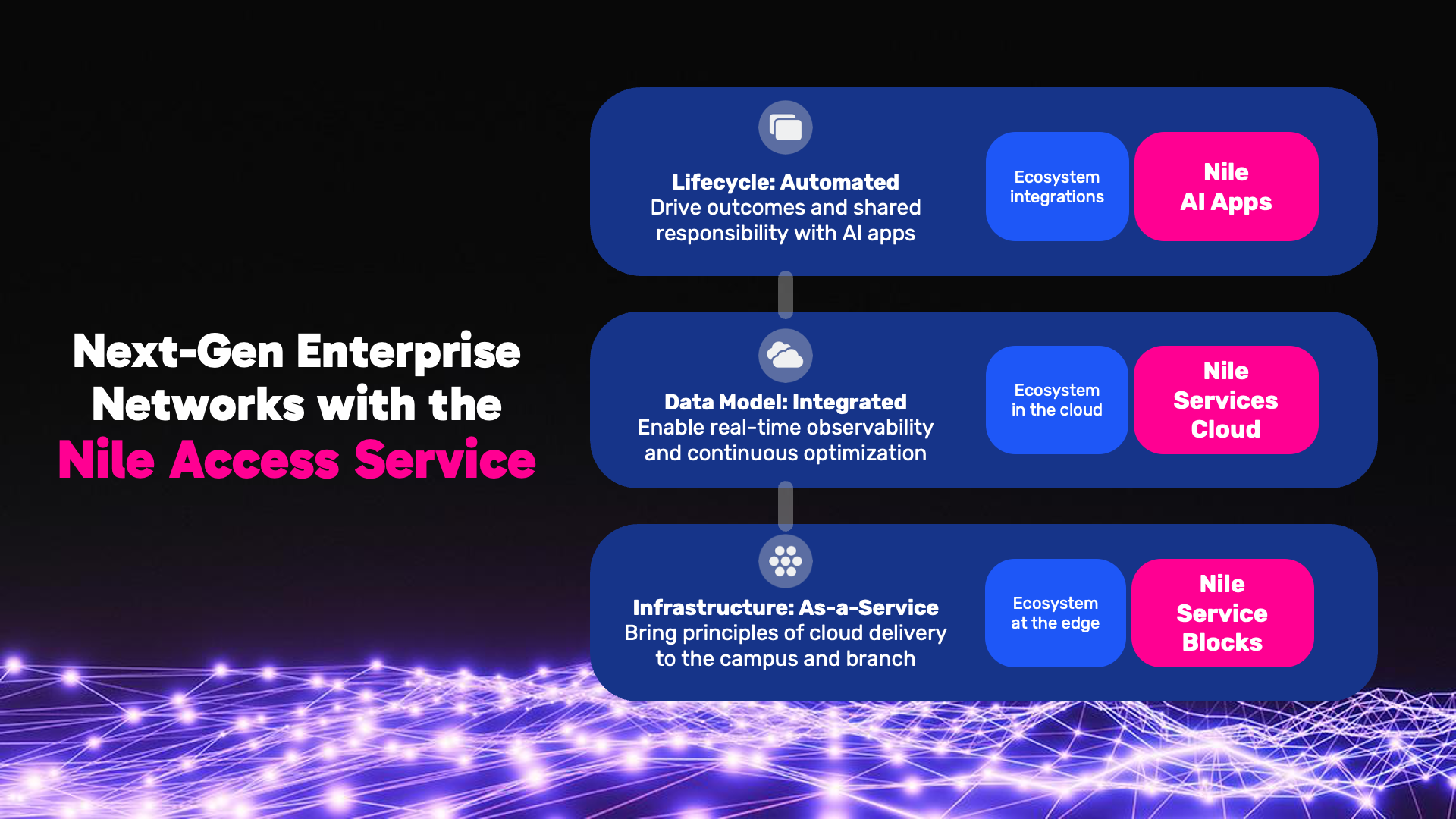
Nile Service Blocks: Edge network infrastructure, designed and delivered by translating infrastructure-as-a-service (IaaS) principles of the cloud to secure wired and wireless connectivity at the enterprise campus and branch.
Nile Services Cloud: Powered by comprehensive data collection from the Nile Service Blocks, Nile Services Cloud enables real-time observability and continuous optimization for the Nile Service Blocks deployed within campus & branch IT infrastructure.
Nile AI Applications: Taking advantage of the integrated data model within the Nile Services Cloud, they not only provide full control and visibility to IT admins, end users and Nile’s production engineering team – but they also help orchestrate the network lifecycle management via simple and intuitive interfaces.
Nile Services Cloud
Customers of the Nile Access Service, across different enterprise campus and branch locations, are not using one product here, and another one there. Acting as tenants of a single service, all components of their enterprise networks have completely transitioned over to Nile.
This single and integrated solution deployment across all our customer tenants gives Nile a great amount of data points to be able to validate layers of our technology architecture. It allows the creation of the Nile Services Cloud that is powered by an integrated data model to “shift left” and integrate traditionally manual network operations from day -1 to day N into our technology architecture.
With Nile Services Cloud, hardware and software innovation within the Nile Service Block for secure wired and wireless connectivity does not come at the expense of operational burden for enterprise IT teams.
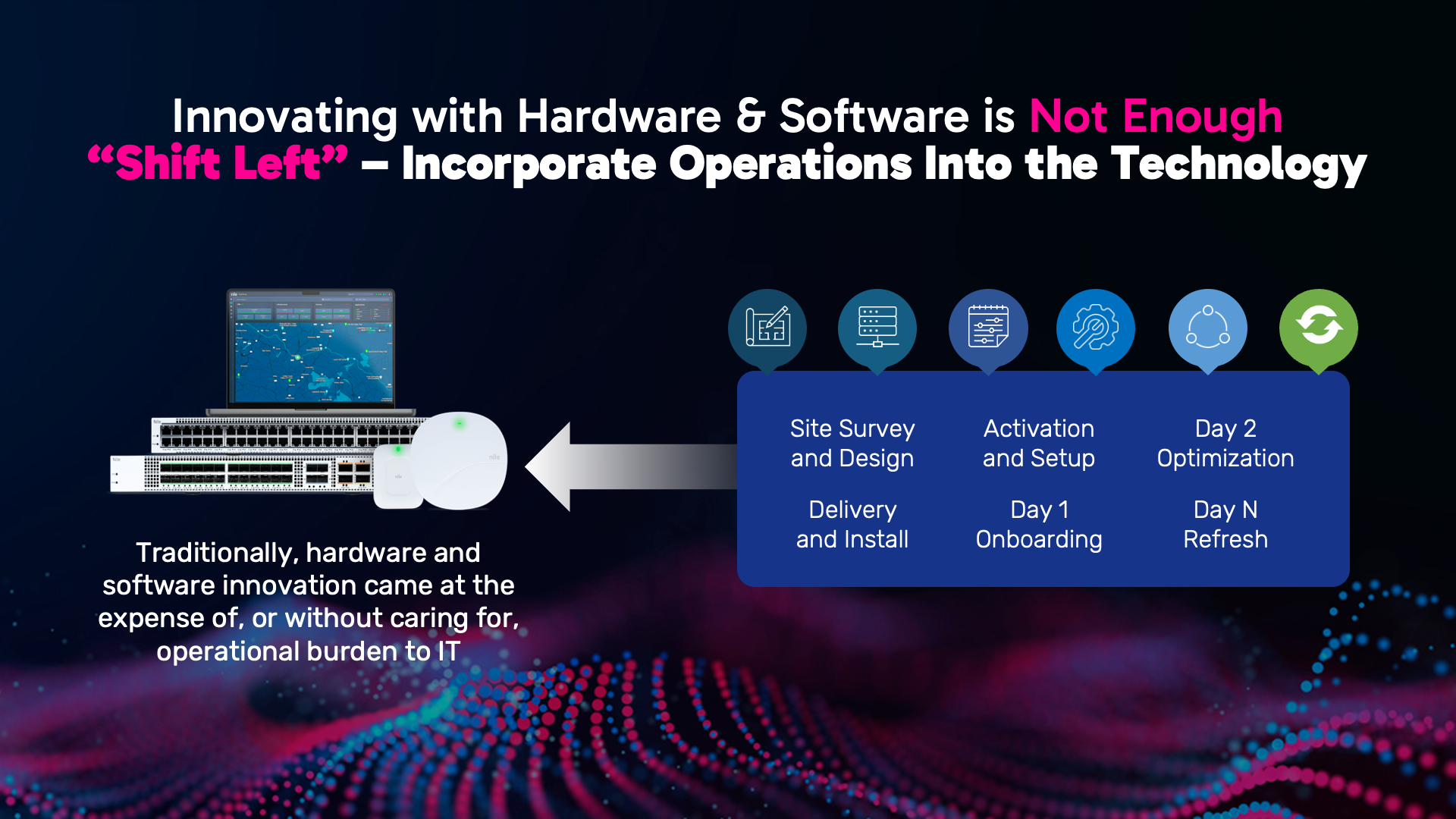
The multi-tenant data store is built within the Nile Service Cloud with the capability of handling volume, variety and velocity of data from different data sources. This comprehensive data collection enables a variety of closed loop automation capabilities, going beyond AI generated summaries of network management reports. The goal with closed loop automation driven by the Nile Services Cloud is to completely eliminate manual tasks for IT admins – and not just summarize their task list.
Nile Services Cloud utilizes comprehensive set of data sources across hardware installation, software status and lifecycle management services:
- Design data: Floorplans, building materials, and attenuation modeling
- Build data: Network closet locations and specifications of the physical space
- Install data: Fulfillment logs and photos from the pre- and post-installation
- Telemetry data: Real-time data collection from the Nile Service Block
- Management data: Granular network telemetry via physical/virtual sensors
- Consumption data: User profiles, device fingerprints, and application patterns
Data stores within the Nile Services Cloud include:
- Relational data store that stores management information
- Metric data store that stores telemetry data from network elements
- Event data store that stores events from network elements
- Log data store that stores raw logs from network elements
- Raw data store that stores other types of data – text, images, audio and video.
This scalable data structure enables various analytics capabilities:
- Streaming analytics that process streaming data in real time
- Batch analytics that process data at rest and provide descriptive statistics
- AI/ML models that continuously learn from data to recognize patterns
By unifying disparate data sources into a scalable analytics engine, Nile gains comprehensive insight into network state and user needs.
The integrated data model transforms reactive network management from reactive to closed loop automation.
It boosts network availability by using AI models to detect anomalies like cabling errors and power fluctuations in real-time. It automatically reroutes traffic around issues to maintain uptime. For optimal performance, Nile Services Cloud continuously adapts Wi-Fi parameters to align with user experience needs. To strengthen security, the system profiles network behavior to isolate and block malicious traffic.
By infusing its network service with AI, Nile also achieves new levels of operational efficiency. Its automated design capability leverages AI to optimize access point placement based on signal requirements, building layouts, and application needs. For installation, Nile detects issues like suboptimal mounting to ensure flawless deployment quality.
The system accelerates root cause analysis by constructing a topological understanding of network dependencies. This allows it to suppress downstream effects and pinpoint true root causes while reducing alert noise. AI-powered software upgrades minimize disruption by automatically rerouting traffic and rolling back in case of adverse effects.
In summary, with an integrated data model within the Nile Services Cloud, Nile AI optimizes network availability, performance, security, and operations via autonomous real-time optimization, behavioral analysis, topology mapping, and predictive intelligence.
Nile Services Cloud elevates enterprise networks from static plumbing to intelligent and adaptive infrastructures.
Powered by its integrated data model, here are the market defining and unique capabilities of the Nile Services Cloud.
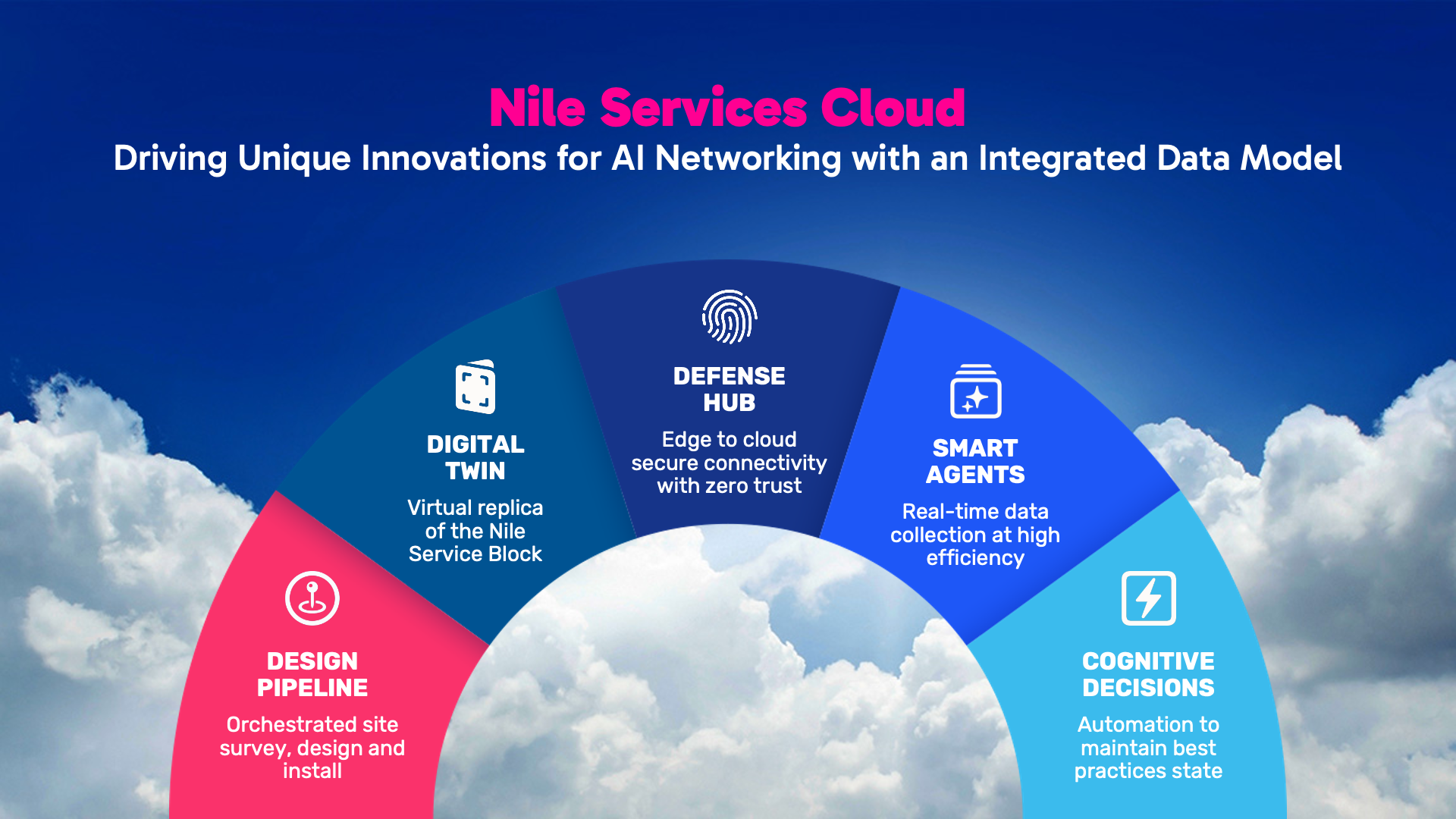
Design Pipeline: Orchestrated site survey, design and install
Nile’s design pipeline fully automates planning, designing and installing of Nile Service Blocks. It’s unique capabilities as part of the Nile Services Cloud include:
- Automate network site survey and planning given user, devices and app requirements
- Auto-generate bill of materials (BOM), network topology and installation work orders
- Installer mobile app with automated work orders for service delivery partners
- One touch activation of the Nile Wi-Fi access points, switches and physical sensors
- Eliminate poor installs by automatically validating against topology & design
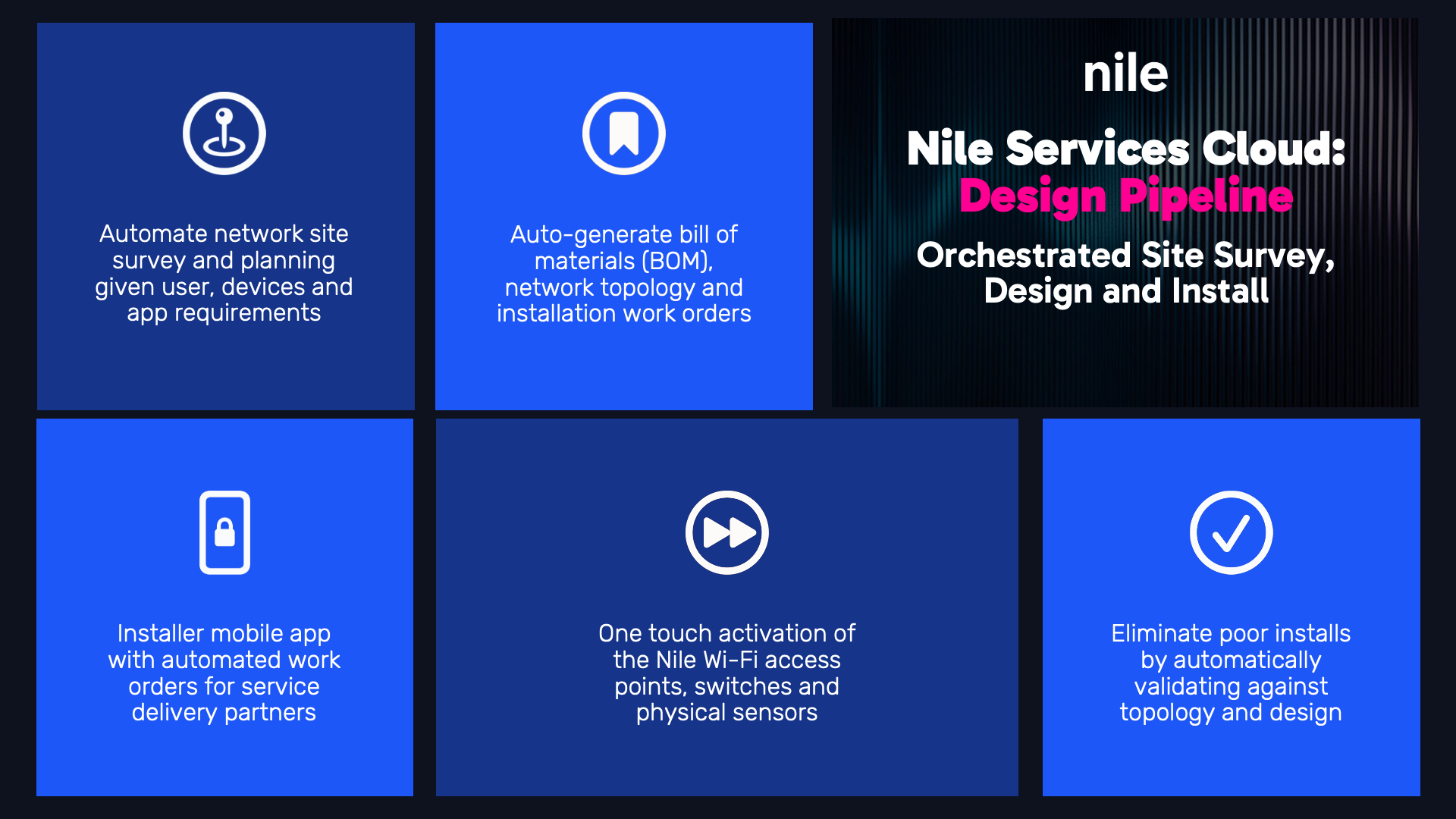
Digital Twin: Virtual replica of the service block
Digital twin faithfully replicates the physical topology of the Nile Service Block and helps track service quality against coverage, capacity and/or availability performance guarantees. It’s unique capabilities as part of the Nile Services Cloud include:
- Simplified full stack system orchestration instead of traditional manual configuration
- High fidelity virtual representation of the deployed network architecture
- Automated comparison of the network snapshot to its ideal design state
- Automated insights on overall network health and individual network elements
- Automated troubleshooting in case of network related or external issues
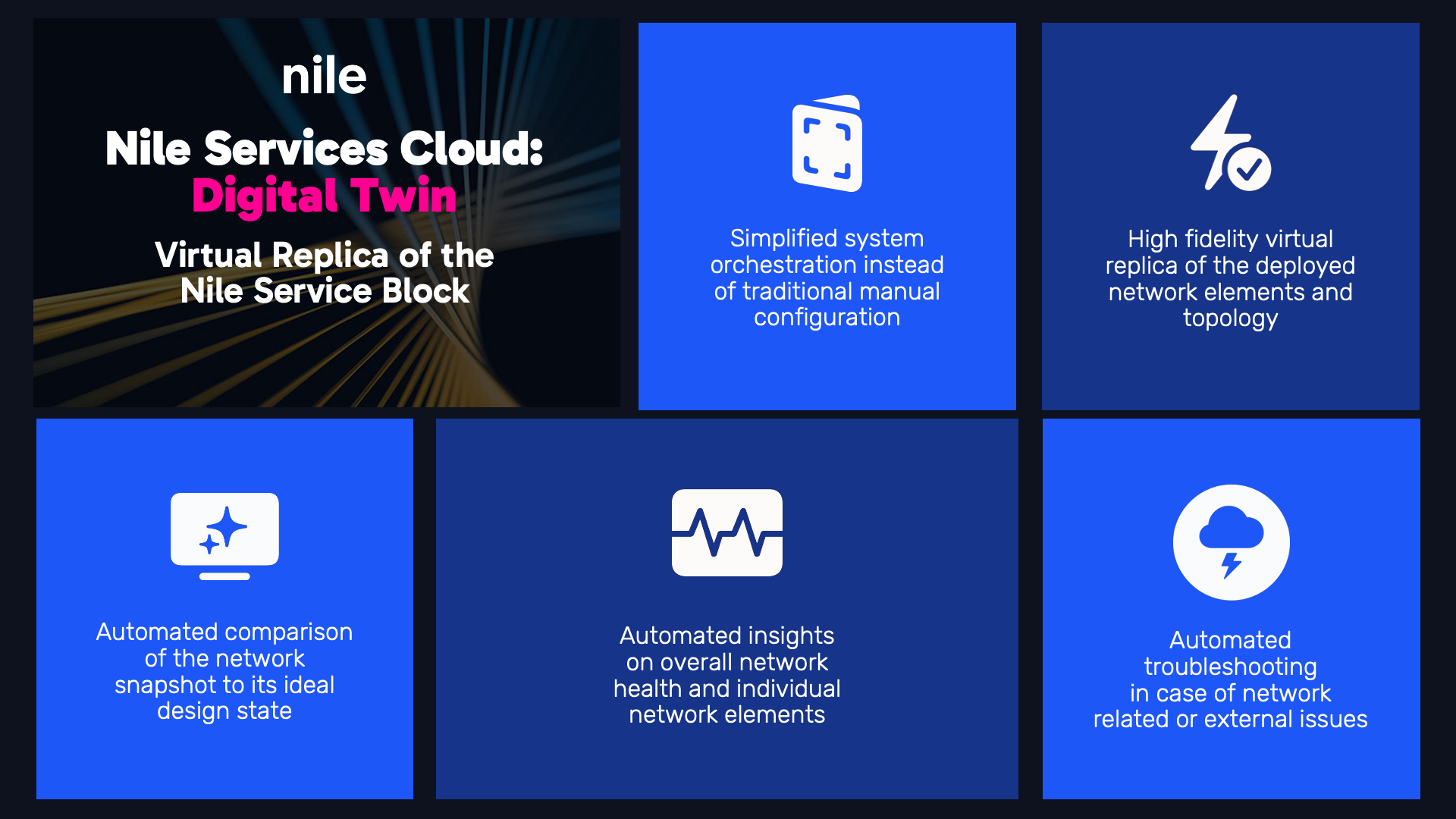
Defense Hub: Edge to cloud zero trust security for the service block
Defense Hub enables edge to cloud zero trust security for the Nile Service Block. It’s unique capabilities as part of the Nile Services Cloud include:
- 802.1x auth for users, SSO auth for BYOD, and dynamic device profiling for IoT devices
- Dynamic policy orchestration per user / device and with external security systems
- Bring Your Own Key (BYOK): Encrypt your data in the Nile cloud with your own keys
- Wireless IDS that’s always on, taking advantage of dedicated radios on the Nile APs
- CSA Star Level One, ISO 27001, and SOC Type II certifications for security compliance

Smart Agents: Real-time data collection at high efficiency
Smart agents continuously monitor all aspects of the Nile Service Block, including network element telemetry data, environmental conditions such as power, cabling status, etc. Smart agents orchestrate this data collection via software and hardware sensors within the Nile Service Block, and tackle post-processing within the Nile Services Cloud. It’s unique capabilities as part of the Nile Services Cloud include:
- Orchestrate physical & virtual sensors to test for coverage, capacity and availability
- Automatically adjust testing scope based on popular end user apps in the network
- Per second collection of system logs & instrumentation data from network elements
- Deep instrumentation to capture data on user, device and app experiences
- Snapshots of network state before-and-after software upgrades & security patches

Cognitive Decisions: Automation to maintain best practices state
Cognitive decisions analyzes the collected data using streaming analytics and AI/ML to proactively detect deviations in system, user, device, and application status from baseline performance. It is designed to make sure that a Nile Service Block can automatically maintain its best state at all times. It’s unique capabilities as part of the Nile Services Cloud include:
- Streaming analytics to process real-time data for root cause analysis and notifications
- Batch analytics that process data at rest and provide descriptive system statistics
- Pattern recognition and predictions with AI/ML models based on real-time data
- Automated transmission of inferred decisions to on-premises network elements
- Designed to self-improve with hitless upgrades to on-prem microservices software

Conclusions
Acting as the brains behind the Nile Access Service, Nile Services Cloud drives closed loop automation for traditionally manual network operations. When reviewing the details behind the third layer of our solution architecture, Nile AI applications, you will get to see clear examples of how Nile Services Cloud utilizes model- and data-centric AI to integrate traditionally manual network operations within the wired and wireless network tech stack.
Thanks to the deterministic system design and comprehensive data collection enabled across the Nile Service Blocks, Nile Services Cloud moves enterprise networks beyond “cloud management portals”. Powered by its integrated data model, instead of relying on cloud just for the sake of easing network management, it acts as the secret ingredient in enabling cloud-like service delivery at the enterprise edge, across campus and branch networks.